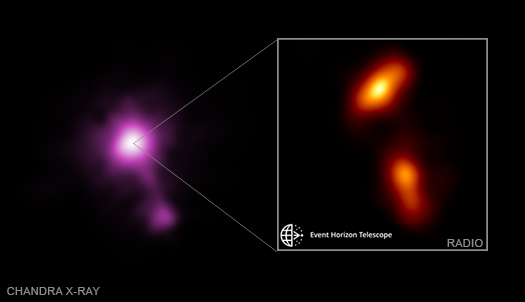A Very Mysterious Direction in the Universe

Konstantinos (Kostas) Migkas
We are pleased to welcome Konstantinos (Kostas) Migkas as a guest blogger. Kostas is a doctoral researcher in the Argelander Institute of Astronomy of the University of Bonn, Germany, and led the study that is the subject of our latest press release. He received his Bachelor's degree in Physics from the Aristotle University of Thessaloniki, Greece, in 2015. Then he moved to Germany and Bonn to obtain his Master's degree in Astrophysics in 2017. He started his PhD by the end of the same year in the group of Prof. Thomas Reiprich working on cosmology with galaxy clusters, exploiting a novel method they designed to study one of the key principles of cosmology.
Our understanding of the Universe has significantly improved in the last 25 years. The accelerating expansion of the Universe, the detailed observation of the leftover relic radiation from the Big Bang (cosmic microwave background, or CMB), the in-depth study of the Universe's structure and the unfolding of the cosmos in the whole range of the electromagnetic spectrum are some of the accomplishments that led astronomers to precisely constrain the so-called cosmological parameters. The latter describe the properties of the Universe in various ways. These include: how much "normal" and "dark" matter the Universe contains, the nature of the mysterious dark energy, and maybe most importantly, the expansion rate of the Universe.
To push cosmological knowledge forward, scientists have to inevitably make some assumptions about the Universe. One of the most fundamental ones is that it acts the same way towards every direction of the sky. Practically, this means that the behavior of the astrophysical objects, for instance galaxies or clusters of galaxies, should look the same no matter where we look. It also means that the cosmological parameters, including the expansion rate of the Universe, must be the same independent of the direction. We call this property "isotropy".
A Golden Age for Exploring the Paradoxes of Black Holes
In a universe full of exotic objects, black holes still manage to stand out for their extreme behavior and the paradoxes they display. They are the darkest objects we know about, but generate so much light they can be identified across most of the observable universe. They are famous for inexorably pulling in matter, but they can also fire off jets at almost the speed of light and create structures much larger than our galaxy. They can tear stars apart, but also nurture bursts of star formation across entire galaxies.
Discoveries like these with NASA's Chandra X-ray Observatory continue to mount, along with results from its sister observatory, the Hubble Space Telescope and other telescopes. Marking a golden age for the study of black holes, these telescopes have been joined in the last few years by two remarkable observatories, the Laser Interferometer Gravitational-Wave Observatory (LIGO) and the Event Horizon Telescope (EHT).
How To Do Particle Physics With Chandra
We are pleased to welcome Chris Reynolds as our guest blogger. Chris is a professor in the Institute of Astronomy at the University of Cambridge in the United Kingdom, and led the study that is the subject of our latest press release. He received his Bachelors degree in Physics and Theoretical Physics from the University of Cambridge in 1992, and continued in Cambridge to graduate with his PhD in astronomy in 1996. He then moved to the University of Colorado Boulder for five years as a post-doctoral fellow and Hubble Fellow, before joining the faculty of the University of Maryland's Department of Astronomy. In 2017, after 16 years as a professor at the University of Maryland, he was lured back to Cambridge to take up the position of Plumian Professor of Astronomy and Experimental Philosophy. Chris is a high-energy astrophysicist who mainly works on the properties of supermassive black holes, although he has taken a detour into particle physics with his latest work, which is the subject of this blog post.
A little over 200 million light years from us lies the Perseus cluster, a swarm of a thousand galaxies trapped within the space of just a couple of million light years by the gravitational field of a massive ball of dark matter. This gravitational field doesn't just confine the galaxies. It also holds onto an atmosphere of hot (40-60 million Kelvin) gas that fills the space between the galaxies; this matter is known as the “intracluster” medium. At the center of all of this lies the unusual galaxy NGC1275, and at the center of this galaxy is a supermassive black hole that is driving powerful jets out into the intracluster medium. When my team observed the active galactic nucleus (AGN) in NGC1275 with the Chandra X-ray Observatory in late 2017, we thought that our focus would be the properties of this black hole and how it interacted with its surroundings. Little did we know that we'd be publishing a paper on particle physics, setting the tightest limits to date on light axion-like particles with implications for string theory!
Excavating a Dinosaur in a Galaxy Cluster
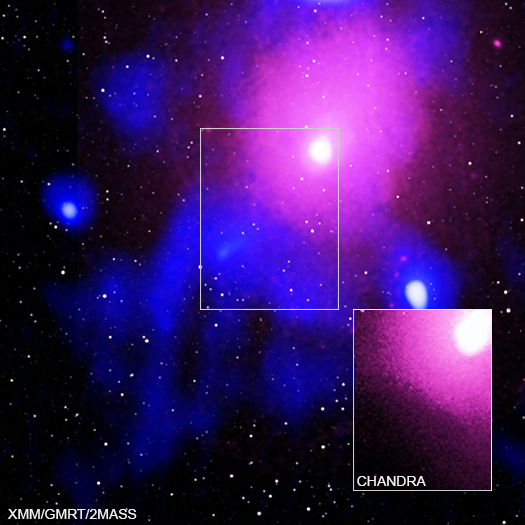
Ophiuchus Galaxy Cluster
Credit: X-ray: Chandra: NASA/CXC/NRL/S. Giacintucci, et al., XMM-Newton: ESA/XMM-Newton;
Radio: NCRA/TIFR/GMRT; Infrared: 2MASS/UMass/IPAC-Caltech/NASA/NSF
We are pleased to welcome two guest bloggers, Maxim Markevitch and Simona Giacintucci, who led the study described in our latest press release. Markevitch, an expert on galaxy clusters X-ray studies, got his PhD at the Space Research Institute of the Russian Academy of Sciences. He worked on ASCA X-ray data in Japan, then at the Chandra X-ray Center for the first 10 years of Chandra operations, and is now at the NASA Goddard Space Flight Center. He received the AAS Rossi Prize. Giacintucci, the lead author of the study, is an expert in radio phenomena in galaxy clusters. She got her PhD at Bologna University. She was a postdoc at the CfA and an Einstein fellow at the University of Maryland, and is now at the Naval Research Lab.
Galaxy clusters are colossal concentrations of dark matter, galaxies, and tenuous, 100-million-degree plasma. This plasma — gas where the electrons have been stripped from their atoms — slowly loses heat by emitting radiation in the form of X-rays. Around the central peaks of many clusters, where matter concentrates, the plasma gets dense enough* to cool quite fast, on a timescale shorter than the cluster's lifetime (a few billion years). The higher the plasma's density, the more X-rays it emits and the faster it cools. As it cools down, it contracts and becomes denser still, and so on, entering a runaway cooling process. Left unchecked, this process should deposit vast quantities of cold gas in the cluster centers.
We know for a fact that the plasma cools down because we do observe those X-rays — but we don't find nearly as much cold gas in the cluster centers as such runaway cooling must deposit. This has been a puzzle for a long while, and the solution the astronomers converged upon is that there must be some source of additional heat in the central regions of clusters — their “cores” — that doesn't let the plasma cool below 10 million degrees or so.
Early Chandra X-ray images of galaxy clusters pointed to the likely source: the supermassive black holes (SMBH) that sit in the centers of the cluster central galaxies, pull in the surrounding matter, and eject a tiny part of it (just before it sinks irretrievably into the black hole) at nearly the speed of light back into the surrounding gas. Where those jets hit the gas, they blow huge bubbles in it, stir it, generate shocks like sonic booms, etc. (all of these features have been seen in the Chandra images of the cluster cores). The current wisdom holds that these processes together supply the needed heat to prevent runaway cooling from occurring, but at the same time are not so powerful that they blow up the whole plasma cloud, implying some kind of a gentle, self-regulated feedback loop may be occurring.
A Cosmic Jekyll and Hyde
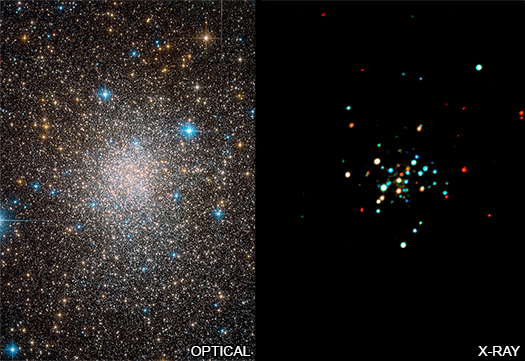
Terzan 5
Credit: X-ray: NASA/CXC/Univ. of Amsterdam/N.Degenaar, et al.; Optical: NASA, ESO/F.Ferraro
A double star system has been flipping between two alter egos, according to observations with NASA's Chandra X-ray Observatory and the National Science Foundation's Karl F. Jansky Very Large Array (VLA). Using nearly a decade and a half worth of Chandra data, researchers noticed that a stellar duo behaved like one type of object before switching its identity, and then returning to its original state after a few years. This is a rare example of a star system changing its behavior in this way.
Astronomers found this volatile double, or binary, system in a dense collection of stars, the globular cluster Terzan 5, which is located about 19,000 light years from Earth in the Milky Way galaxy. This stellar duo, known as Terzan 5 CX1, has a neutron star (the extremely dense remnant left behind by a supernova explosion) in close orbit around a star similar to the Sun, but with less mass.
Stellar Explosions and Jets Showcased in New Three Dimensional Visualizations
Your browser does not support the video tag.
Compilation of 3D Models
Credit: NASA/CXC/INAF-Osservatorio Astronomico di Palermo/Salvatore Orlando
Since ancient times, the study of astronomy has largely been limited to the flat, two-dimensional projection of what appears on the sky. However, just like a botanist puts a plant under a microscope or a paleontologist digs for fossils, astronomers want more "hands on" ways to visualize objects in space.
A new set of computer simulations represents an exciting step in that direction. Each is a three-dimensional (3D) visualization of an astronomical object based on data from NASA's Chandra X-ray Observatory and other X-ray observatories. While unable to fly to these distant objects and travel around them, astronomers have used data from these observatories to learn about the geometry, velocity, and other physical properties of each of these cosmic sources.
Famous Black Hole Has Jet Pushing Cosmic Speed Limit
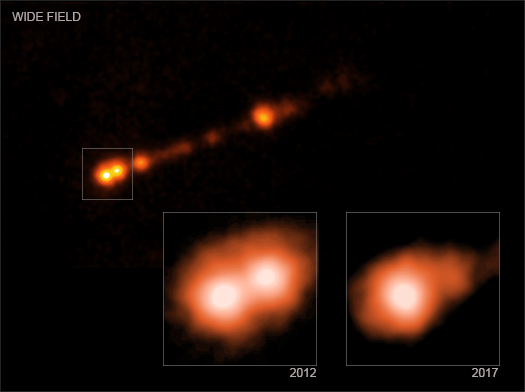
Supermassive Black Hole Jet in M87
Credit: NASA/CXC/SAO/B.Snios et al.
These images show evidence from NASA's Chandra X-ray Observatory that the black hole in the galaxy Messier 87 (M87) is blasting particles out at over 99% the speed of light, as described in our latest press release. While astronomers have observed features in the M87 jet blasting away from its black hole this quickly at radio and optical wavelengths for many years, this provides the strongest evidence yet that actual particles are travelling this fast. Astronomers required the sharp X-ray vision from Chandra in order to make these precise measurements.
The main panel of the graphic shows the entire length of M87's jet seen by Chandra, stretching for about 18,000 light years. "Knots" of X-ray emission seen here are created when material falls onto the M87 sporadically, creating bursts of X-ray light that travel along the jet and away from the black hole. The insets show Chandra observations taken in 2012 and 2017 of a small region near the base of the jet. The source in the lower left is X-ray emission from material around the black hole, and the other source is a knot in the jet about 900 light years from the black hole. This knot moves away from the black hole between 2012 and 2017 and also fades by 70%.
NASA's Great Observatories Help Astronomers Build a 3D Visualization of Exploded Star
In the year 1054 AD, Chinese sky watchers witnessed the sudden appearance of a "new star" in the heavens, which they recorded as six times brighter than Venus, making it the brightest observed stellar event in recorded history. This "guest star," as they described it, was so bright that people saw it in the sky during the day for almost a month. Native Americans also recorded its mysterious appearance in petroglyphs.
Observing the nebula with the largest telescope of the time, Lord Rosse in 1844 named the object the "Crab" because of its tentacle-like structure. But it wasn't until the 1900s that astronomers realized the nebula was the surviving relic of the 1054 supernova, the explosion of a massive star.
Now, astronomers and visualization specialists from the NASA's Universe of Learning program have combined the visible, infrared, and X-ray vision of NASA's Great Observatories to create a three-dimensional representation of the dynamic Crab Nebula. Certain structures and processes, driven by the pulsar engine at the heart of the nebula, are best seen at particular wavelengths.
Galaxy Gathering Brings Warmth
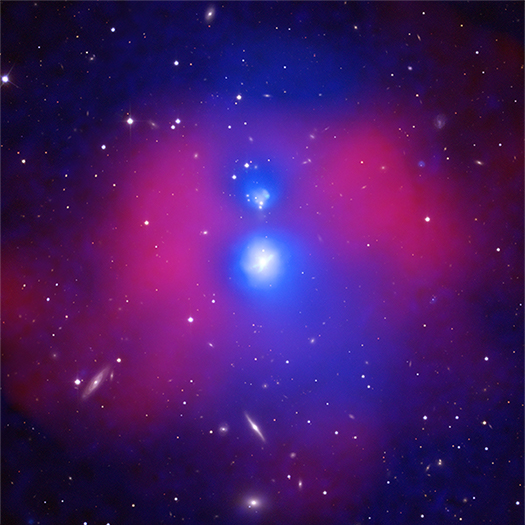
NGC 6338
Credit: X-ray: Chandra: NASA/CXC/SAO/E. O'Sullivan; XMM: ESA/XMM/E. O'Sullivan; Optical: SDSS
As the holiday season approaches, people in the northern hemisphere will gather indoors to stay warm. In keeping with the season, astronomers have studied two groups of galaxies that are rushing together and producing their own warmth.
The majority of galaxies do not exist in isolation. Rather, they are bound to other galaxies through gravity either in relatively small numbers known as "galaxy groups," or much larger concentrations called "galaxy clusters" consisting of hundreds or thousands of galaxies. Sometimes, these collections of galaxies are drawn toward one another by gravity and eventually merge.
Using NASA's Chandra X-ray Observatory, ESA's XMM-Newton, the Giant Metrewave Radio Telescope (GMRT), and optical observations with the Apache Point Observatory in New Mexico, a team of astronomers has found that two galaxy groups are smashing into each other at a remarkable speed of about 4 million miles per hour. This could be the most violent collision yet seen between two galaxy groups.
A Friendly Neighborhood Supermassive Black Hole

Roberto Gilli
We are very happy to welcome Roberto Gilli as our guest blogger. Dr. Gilli is the first author of a paper that is the subject of our latest Chandra press release. He received his Ph.D. in astronomy from Firenze University in Italy in 2001. Afterward, he did a post-doctoral fellowship at The Johns Hopkins Observatory before returning to Firenze at the Arcetri Astrophysical Observatory. Today, he is an astronomer at the National Institute of Astrophysics (INAF) in Bologna, Italy, a position he has held since 2005. His research interests include active galactic nuclei, quasars, and deep X-ray surveys.
Black holes are usually perceived as dangerous, disruptive systems. On the one hand they swallow copious amount of matter. On the other, they release a large amount of energy in the form of both radiation and matter when enormous quantities of material fall onto them.
The most extreme manifestation of such phenomenon is known as a "quasar" or an "active galactic nucleus" (AGN) that are powered by growing supermassive black holes (SMBHs) at galaxy centers. During these growth phases, part of the gravitational energy of the infalling gas is converted into strong electromagnetic radiation. Meanwhile, some of the gas, rather than being swallowed by the black hole, is instead accelerated and pushed very far away in the form of fast winds or even faster jets that can approach the speed of light.

